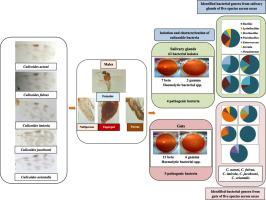蓝舌病病毒传播媒介库蠓属(双翅目:蠓科)唾液腺和肠道细菌群落的种内种间比较。
IF 2.5
3区 医学
Q2 PARASITOLOGY
引用次数: 0
摘要
媒介物种中的细菌可以影响各种生理特性,包括可能的消化,营养,生存能力和繁殖力。昆虫体内的细菌群落在不同组织中有所不同,并根据饮食习惯、宿主分类群和胎次而改变。唾液腺和肠道是病原体复制和传播的两个重要器官。尽管有关于病毒、原生动物和线虫的各种记录,但在蓝舌病病毒(BTV)的五种媒介中,唾液腺(SG)和肠道(GT)内的细菌群落数据缺乏,这些媒介是库蠓(Culicoides actoni Smith)、C. fulvus Sen & Das Gupta、C. imicola Kieffer、C. jacobsoni Macfie和C. orientalis Macfie。有充分的文献证明,某些细菌可以影响蠓的病毒载体能力。研究了5个野外采集种的不同性别和不同年龄的雌虫SG和GT中可培养细菌的组成,揭示了与载体种相关的细菌在不同性别和不同器官中的种间和种内变化。通过生化试验和部分16S rRNA基因的Sanger测序鉴定细菌菌落。共分离到114株细菌,其中从5个菌种中分别分离到61株和53株。分离物属于厚壁菌门和变形菌门。5种细菌属的相对丰度分别为:SG- i) C. actoni: Bacillus(11.47%)、Lysinibacillus(1.63%)、Paenibacillus(4.91%)、Enterococcus(1.63%)、Serratia (1.63%);ii)黄弧菌:芽孢杆菌(11.47%)、肠球菌(3.27%);iii) C. imicola:芽孢杆菌(13.11%)、短芽孢杆菌(1.63%)、Paenibacillus(3.27%)、肠球菌(3.27%);iv)雅可氏梭菌:芽孢杆菌(11.47%)、类芽孢杆菌(1.63%)、肠球菌(4.91%)和v)东方梭菌:芽孢杆菌(13.11%)、类芽孢杆菌(3.77%)、假单胞菌(1.88%)和GT- i)行动梭菌:芽孢杆菌(7.54%)、溶血杆菌(9.43%)、类芽孢杆菌(1.88%)、沙雷氏菌(1.88%);ii)黄芽孢杆菌:芽孢杆菌(9.43%)、赖氨酸芽孢杆菌(1.88%)、胞杆菌(1.88%)、假单胞菌(1.88%);iii) C. imicola:芽孢杆菌(16.98%)、溶杆菌(5.66%)、短芽孢杆菌(1.88%);iv)雅可氏c:芽孢杆菌(15.09%);v)东方c:芽孢杆菌(18.86%)、短芽孢杆菌(3.77%)、假单胞菌(1.88%)。具有溶血活性的细菌有:芽孢杆菌5号、溶血杆菌3号、红壤胞杆菌3号、副短芽孢杆菌3号、粪芽孢杆菌3号、黄芽孢杆菌5号、粘质葡萄球菌3号、猪假单胞菌5号,而具有溶血活性的细菌有芽孢杆菌5号和芒果铁杆菌5号。首次鉴定出SG菌群及其溶血菌群。这个溶血肠道细菌库可以进一步检测它们在体内血液消化中的可能作用。我们的研究结果记录了SG中存在以下致病菌:蜡样芽孢杆菌、副短芽孢杆菌、梭状芽孢杆菌、粘质芽孢杆菌和史图氏芽孢杆菌,这些细菌可能通过摄食血液传播给宿主。本文章由计算机程序翻译,如有差异,请以英文原文为准。

Intraspecific and interspecific comparison among bacterial communities in salivary glands and gut of five Culicoides spp. (Diptera: Ceratopogonidae), vectors of bluetongue virus
Bacteria within the vector species can impact various physiological traits, including likely digestion, nutrition, survivability, and fecundity. Bacterial communities within insects vary across tissues and alter depending on diet regime, host taxa, and parity. Salivary glands and the gut are two significant organs for pathogen replication and dissemination. Despite various records on viruses, protozoa, and nematodes, data on bacterial communities within salivary glands (SG) and gut (GT) are lacking within the five vectors of bluetongue virus (BTV), Culicoides actoni Smith, C. fulvus Sen & Das Gupta, C. imicola Kieffer, C. jacobsoni Macfie and C. orientalis Macfie. It is well documented that certain bacteria can impact on vectorial capacity of viruses of biting midges. The culturable bacterial composition is investigated in SG and GT across sexes and age-graded females of five field-collected species to unveil interspecific and intraspecific variation among the bacteria associated with vector species across sexes and different organs. Bacterial colonies were identified by biochemical tests and Sanger sequencing of the partial 16S rRNA gene. A total of 114 bacterial isolates, of which 61 and 53 isolates were retrieved from SG and GT of five species, respectively. The isolates belonged to the phyla Firmicutes and Proteobacteria. Bacillus spp. was the most abundant, followed by Lysinibacillus spp. The relative abundances of bacterial genera identified from five species across sexes and organs are as follows: SG- i) C. actoni: Bacillus (11.47 %), Lysinibacillus (1.63 %), Paenibacillus (4.91 %), Enterococcus (1.63 %), Serratia (1.63 %); ii) C. fulvus: Bacillus (11.47 %), Enterococcus (3.27 %); iii) C. imicola: Bacillus (13.11 %), Brevibacillus (1.63 %), Paenibacillus (3.27 %), Enterococcus (3.27 %); iv) C. jacobsoni: Bacillus (11.47 %), Paenibacillus (1.63 %), Enterococcus (4.91 %) and v) C. orientalis: Bacillus (13.11 %), Paenibacillus (3.77 %), Pseudomonas (1.88 %) and GT- i) C. actoni: Bacillus (7.54 %), Lysinibacillus (9.43 %), Paenibacillus (1.88 %), Serratia (1.88 %); ii) C. fulvus: Bacillus (9.43 %), Lysinibacillus (1.88 %), Cytobacillus (1.88 %), Pseudomonas (1.88 %); iii) C. imicola: Bacillus (16.98 %), Lysinibacillus (5.66 %), Brevibacillus (1.88 %); iv) C. jacobsoni: Bacillus (15.09 %) and v) C. orientalis: Bacillus (18.86 %), Brevibacillus (3.77 %), Pseudomonas (1.88 %). The bacteria exhibiting beta haemolytic activities were: 5 Bacillus spp., 3 Lysinibacillus spp., Cytobacillus kochii, Brevibacillus parabrevis, E. faecium, Paenibacillus lautus, S. marcescens, Pseudomonas stutzeri, while 5 Bacillus spp., and L. mangiferihumi were gamma haemolytic. Bacteria of the SG were identified for the first time, along with the haemolytic microbiota of these species. This repository of haemolytic gut bacteria may be targeted further to detect their probable roles in vivo blood meal digestion. Our findings record the occurrence of the following pathogenic bacteria: Bacillus cereus, Brevibacillus parabrevis, L. fusiformis, S. marcescens, and P. stutzeri within SG, which may be transmitted to their hosts through blood feeding.
求助全文
通过发布文献求助,成功后即可免费获取论文全文。
去求助
来源期刊

Acta tropica
医学-寄生虫学
CiteScore
5.40
自引率
11.10%
发文量
383
审稿时长
37 days
期刊介绍:
Acta Tropica, is an international journal on infectious diseases that covers public health sciences and biomedical research with particular emphasis on topics relevant to human and animal health in the tropics and the subtropics.
 求助内容:
求助内容: 应助结果提醒方式:
应助结果提醒方式:


